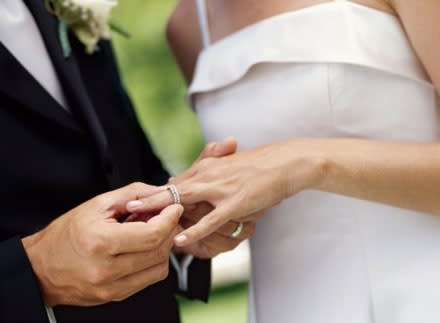Choosing a wedding ring

Size and shape of the wedding ring
When you make your first foray into the world of wedding rings you will be confronted by a lot of industry jargon. Most if it is unnecessarily complicated. The different phrases used basically dictate the shape of the ring from a ‘flat edged’ band to a ‘high domed’ ring and all the varying degrees of curved edge in between.A good jeweller should be able to give a succinct breakdown of the different styles so do not feel intimidated. In general, bear these rules in mind: Consider choosing a narrower wedding band if you would like space to wear your engagement ring on the same finger and don’t forget to leave room to add an eternity ring to the collection in the future. Some couples have the inside of their wedding ring engraved with a personal message to each other or the date of their wedding, so there’s no excuse for forgetting anniversaries. If you would like to do this you should choose a wider wedding band to ensure there is enough space for your text. Many brides choose to have their wedding ring shaped to fit more comfortably next to their engagement ring. You can buy the engagement ring and wedding ring together which are designed to fit the shape of each other, or a good jeweller should be able to alter a wedding band to fit next to an engagement ring.
Material
Choosing the material that your ring is going to be made from is a huge consideration – both aesthetically and financially. Regardless, the material you decide to choose for the bride’s ring will largely be dictated by the colour of her engagement ring and no, the groom’s ring does not have to match the bride’s, leaving the bride free to go for something as elaborately gem studded and feminine as she likes. Here’s a brief guide to the materials used for most rings.
Yellow gold
The most traditional choice. Yellow gold presents a couple of options. 24 carat is the purest and most expensive form, but is also very soft and therefore easily damaged. It is not generally recommended for wedding bands. Wedding rings are usually comprised of gold from 12ct (50% gold) to 18ct (75%) making them much more resistant.
White gold
A material composed by mixing pure gold with another metal to form an alloy. The ‘white’ in white gold does not refer to the silver colour of most white gold rings. This is achieved by plating the outside of the ring with another metal, usually rhodium, to enhance its appearance. White gold rings will complement a silver or platinum engagement ring. The one drawback is that the rhodium plating is likely to wear over time.
Platinum
With its silver hue platinum is extremely rare and the most expensive option available for wedding rings. It is also tough and highly durable.
Titanium
A more modern and fairly trendy choice. Titanium is extremely durable, even when shaped. The metal is naturally dull and subtly grey in colouration.
Inherited rings
An inherited ring passed on to you represents the long and happy marriage enjoyed by your relative. Wear the ring in its current condition as a tribute or even as good luck charm, or alternatively have the precious metal melted down and formed into a new ring. Some may see this as insensitive, but you will still know that your ring has derived from the very same metal that represented your grandparents’ or parents’ love for each other; it has just been reshaped to be unique to you. Still, probably best to run the idea past the family member beforehand.
Top Tips for wedding ring bliss –considerations post purchase
On your wedding day you are likely to be nervous, your hands will be hot and clammy and the wedding ring that was a perfect fit in the shop might suddenly be tricky to get on. This is the last thingyou want with all eyes on you right at the vital moment, so a good tip is to put on a little hand cream just before the ceremony. That way the ring should slip on with ease. After carefully choosing and exchanging your rings the last thing you want to do is lose them on your honeymoon. All that sunscreen, sand and sea mean the ring could easily be misplaced. Consider wearing your ring on a chain around your neck while on honeymoon or leaving it in the hotel safe when you go down to the beach. Check your insurance carefully as some policies state the ring is only insured when it is on your finger. Read more on getwed.com...
Wedding day roles
Top tips for minimising wedding stress
Follow getwed.com on Twitter


